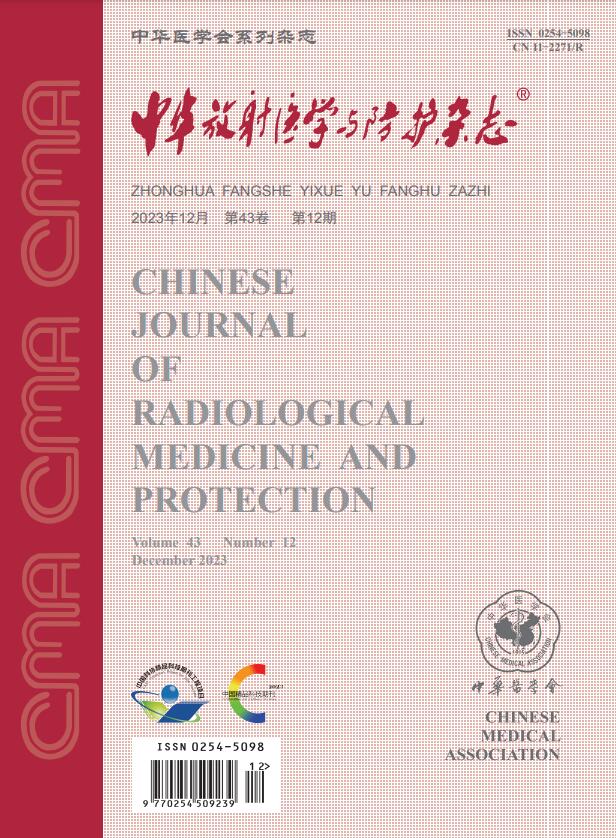Radiation dose control for CT urography based on different body mass index
Q4 Medicine
引用次数: 0
Abstract
Objective To explore the optimization of CT urography imaging parameters and the control measures of radiation dose to patients with different body mass index. Methods A total of 133 patients who were required to undergo CT urography were prospectively selected in terms of three different types of CT urography scan; firstly, conventional parameter scan (120 kV, CARE Dose4D); secondly, low kV scan (BMI ≤ 22.9∶80 kV, 22.9 < BMI < 30∶100 kV, BMI ≥ 30∶120 kV, CARE Dose4D) and thirdly, low mAs scan (120 kV, 40% reduction in mAs on CARE Dose4D). Noise, signal-to-noise ratio (SNR) and contrast-to-noise ratio (CNR) of all images were measured as objective evaluation indicators of image quality. The subjective evaluation of the images was performed by two radiologists who had been working for more than five years using a double-blind method and a 5-score system evaluation. The effective dose values (CTDIvol, DLP, E) in each group were measured. Results Patients′ effective dose was decreased by 77.7% in 80 kV group and 38.3% in 100 kV group, with a statistical difference between the two groups (Z=-3.330, -5.559, P 0.05). There was a statistically significant difference in renal cortex noise and SNR between the 100 kV scan group and the routine scan group (Z=-5.096, -3.566, P 0.05). The effective dose from low mAs scan in the three types of patients was decreased by 38.3%, 32.0%, and 34.7%, respectively, with a statistical difference between them (P 0.05) besides ureteral CNR in the 22.9 < BMI < 30 group (Z=-2.587, P<0.05). The subjective evaluation scores of all images were greater than 3 points. Conclusions In this study, the scan method for low kV and low mAs used for patients with different body mass index can effectively reduce the radiation dose to patients and meet the requirements of clinical diagnosis. Key words: Body mass index; CT urography; Low-dose scan; Urinary system disease基于不同体质指数的CT尿路造影辐射剂量控制
目的探讨不同体质指数患者CT尿路造影成像参数的优化及放射剂量的控制措施。方法根据3种不同类型的CT尿路造影扫描,前瞻性选择133例需要行CT尿路造影的患者;首先,常规参数扫描(120 kV, CARE Dose4D);二是低kV扫描(BMI≤22.9∶80 kV, 22.9 < BMI < 30∶100 kV, BMI≥30∶120 kV, CARE Dose4D),三是低mAs扫描(120 kV, CARE Dose4D使mAs降低40%)。测量所有图像的噪声、信噪比(SNR)和噪声对比比(CNR)作为图像质量的客观评价指标。影像的主观评价由两名工作五年以上的放射科医生进行,采用双盲法和5分制评价。测定各组有效剂量值(CTDIvol、DLP、E)。结果80 kV组患者有效剂量降低77.7%,100 kV组患者有效剂量降低38.3%,两组间差异有统计学意义(Z=-3.330, -5.559, P 0.05)。100 kV扫描组肾皮质噪声、信噪比与常规扫描组比较,差异有统计学意义(Z=-5.096, -3.566, P 0.05)。三种类型患者低mAs扫描有效剂量分别降低38.3%、32.0%、34.7%,差异均有统计学意义(P <0.05)。22.9 < BMI < 30组输尿管CNR差异有统计学意义(Z=-2.587, P<0.05)。所有图像主观评价得分均大于3分。结论本研究对不同体质指数患者采用低kV、低mAs扫描方法,可有效降低对患者的辐射剂量,满足临床诊断的要求。关键词:体质指数;CT尿路造影术;低剂量扫描;泌尿系统疾病
本文章由计算机程序翻译,如有差异,请以英文原文为准。
求助全文
约1分钟内获得全文
求助全文
来源期刊

中华放射医学与防护杂志
Medicine-Radiology, Nuclear Medicine and Imaging
CiteScore
0.60
自引率
0.00%
发文量
6377
期刊介绍:
 求助内容:
求助内容: 应助结果提醒方式:
应助结果提醒方式:


